Last Updated: March 29, 2024
Japan has one of the most developed and rapidly growing e-commerce markets in the world. Global supply chain issues, pandemic restrictions and increased consumer price sensitivity have done little to impact long-term predictions of growth for the nation’s flourishing online shopping industry.
In our first report of this kind, we’re proud to present what we think are the most important stats, trends, and insights worth knowing about e-commerce in Japan — a handy visual reference for online sellers and casual readers alike.
Table of Contents
- Japan’s ecommerce market overview
- Shoppers by age in Japanese ecommerce
- Market share of leading ecommerce segments in Japan
- Most popular types of ecommerce platforms in Japan
- Monthly visits by ecommerce marketplace
- Top first party online selling platforms in Japan by net sales
- Japanese ecommerce trends and insights for 2023
- Expert Insights: Navigating E-Commerce in Japan
- Japanese ecommerce FAQs
- Methodology
- Steal some of our best ideas!
Japan’s Ecommerce Market Overview
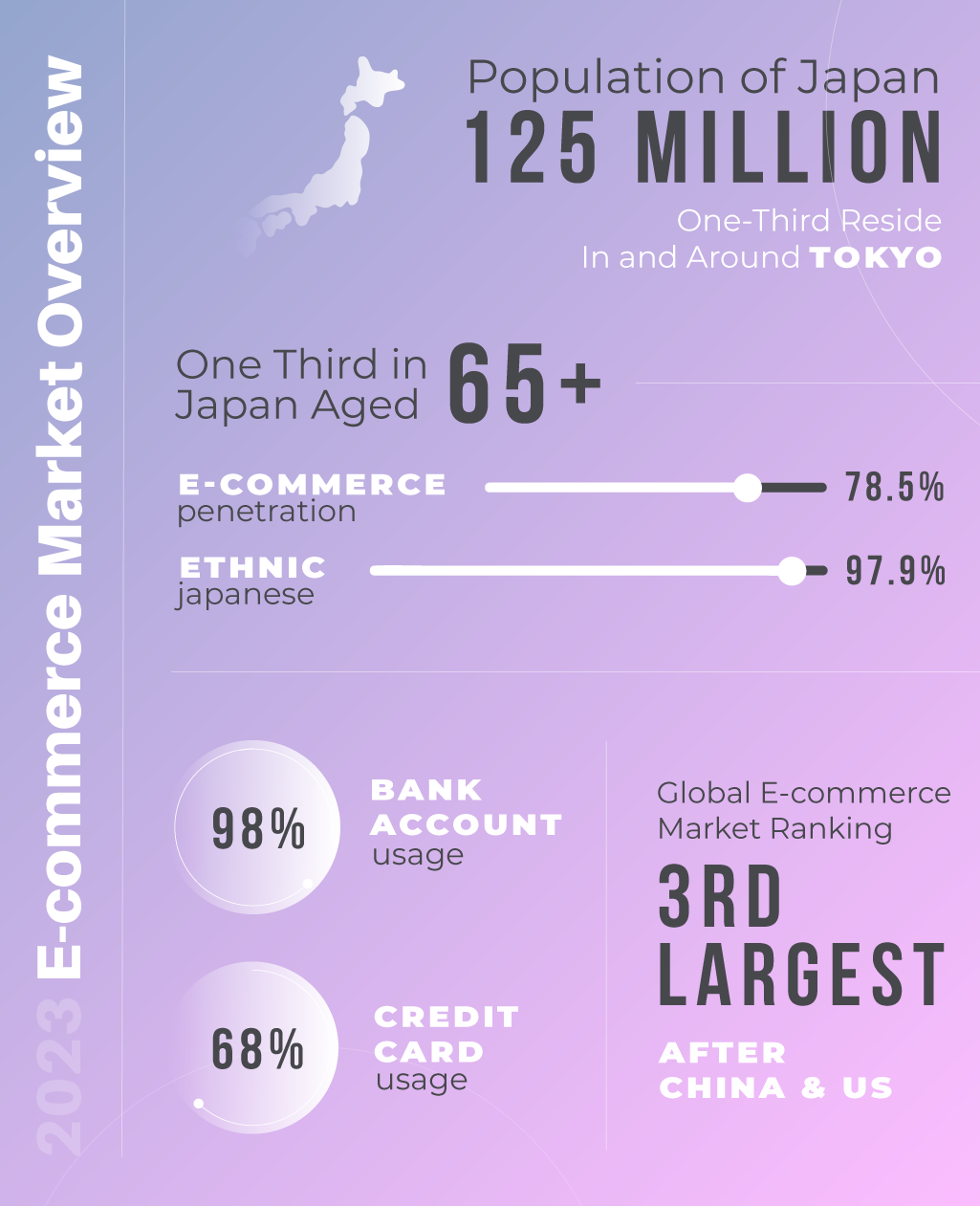
Sources: Statista, Statista, J.P Morgan, CIA World Factbook
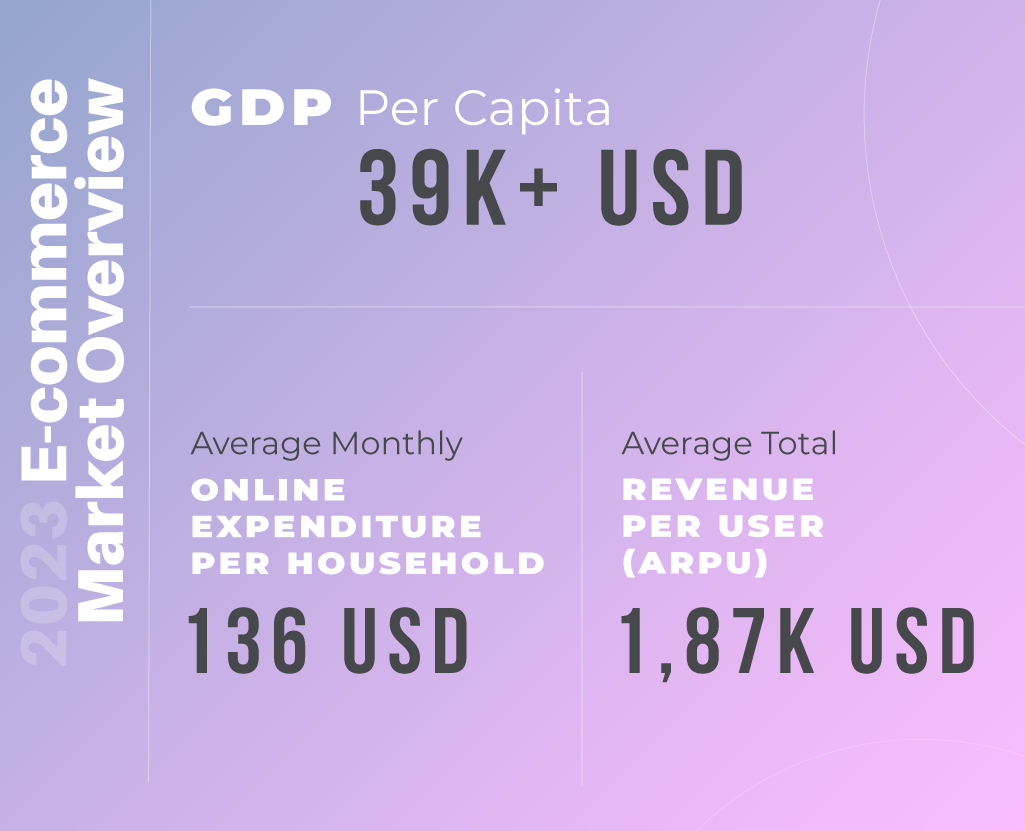
Sources: Statista, Statista, J.P Morgan, CIA World Factbook
Shoppers by Age in Japanese Ecommerce
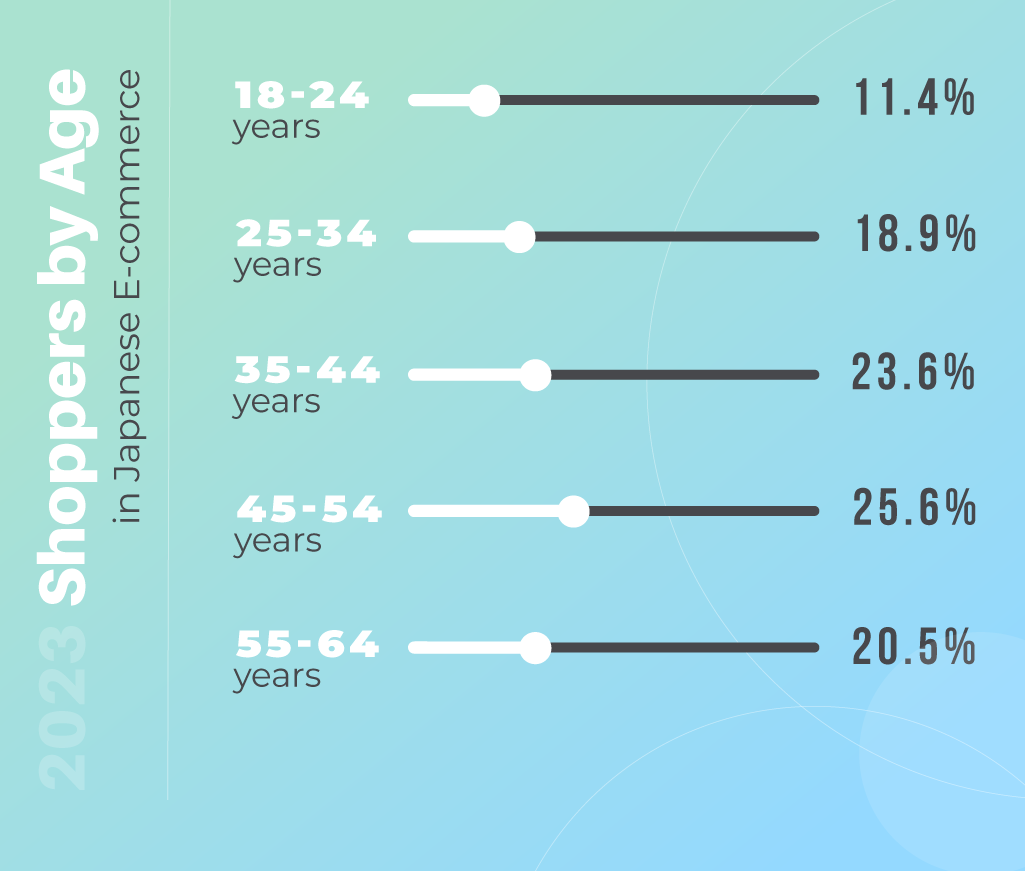
Source: Statista
Market Share of Leading Ecommerce Segments in Japan
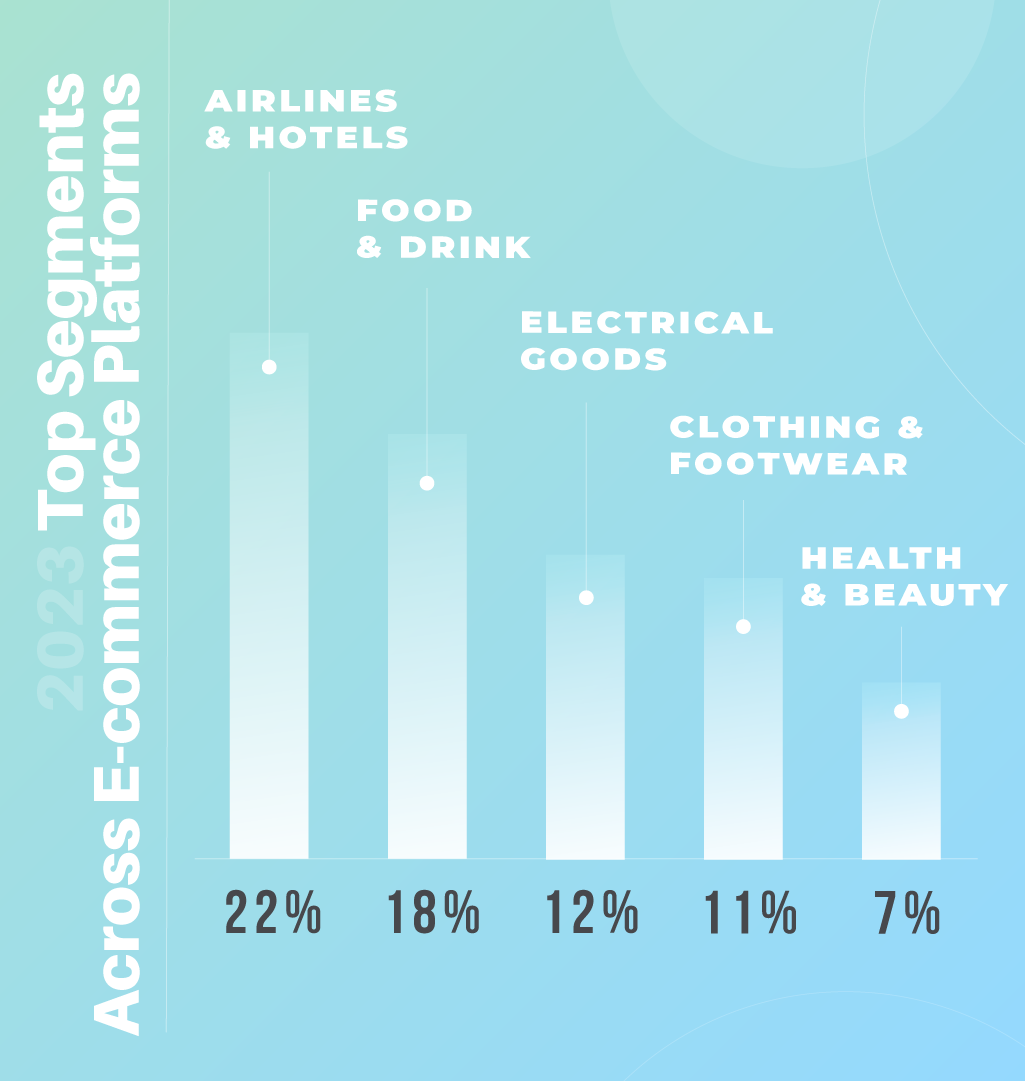
Source: Statista
Most Popular Types of Ecommerce Platforms in Japan
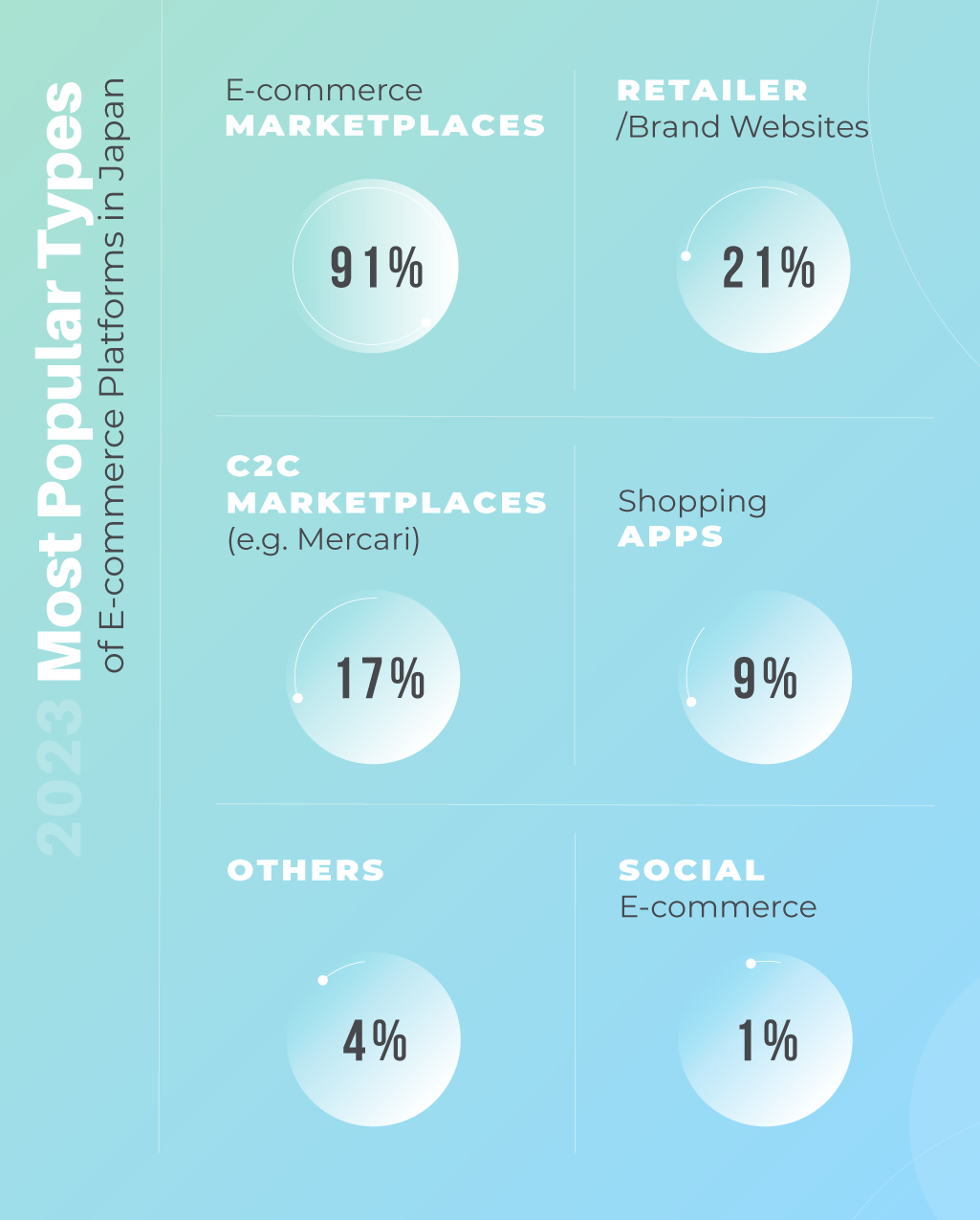
Source: Statista
Monthly Visits by Ecommerce Marketplace
*Tap or Hover on the graph below to see details.
Source: SimilarWeb’s March 2023 domain overview
Amazon
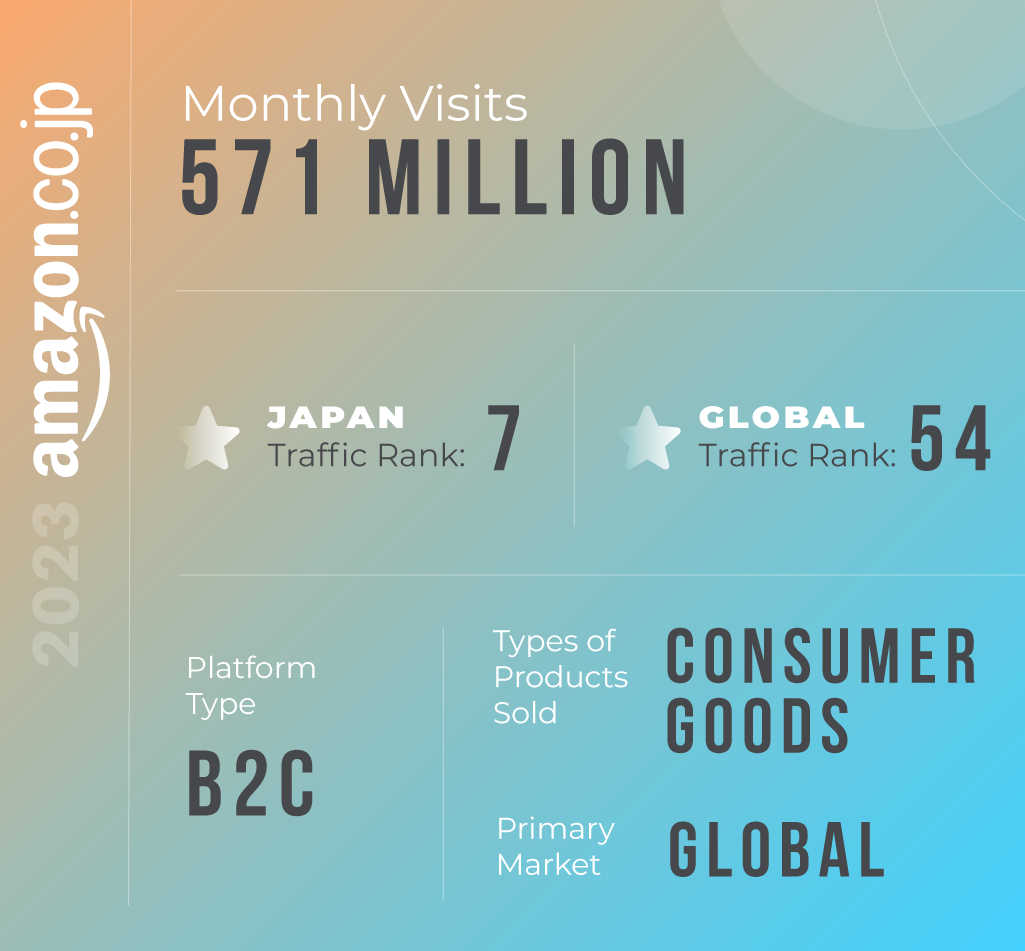
Amazon’s heavy investments into the Japanese market since the early 2000’s have helped it secure top place as the nation’s go-to platform for online shopping.
The global e-commerce giant now enjoys consistently higher traffic volumes and sales revenue than all other marketplaces, including Rakuten.
The company’s Fulfillment by Amazon (FBA) service operates out of over 20 fulfillment centers and its additional Amazon delivery centers give its logistics network unrivaled coverage across the country—ensuring deliveries are consistently smooth and efficient.
Key Platform Features
- A reliable fulfillment option (FBA) offers merchants an easy way to maintain delivery standards and meet high customer service expectations in Japan
- Product listings are displayed directly next to competitors in search results, making price, reviews and ratings key determining factors in customer purchases for items that are similar or identical
- Several advanced paid advertising options including Amazon Sponsored Products (ASP) help sellers drive greater traffic and sales
- International sellers can consolidate product listings with the ‘Build International Listings’ feature—adding offers and synchronizing prices across multiple global marketplaces
- The Amazon Points loyalty system is one of Japan’s most popular schemes
Tips for Selling On Amazon in Japan
Amazon is our recommended platform for international companies that are selling in Japan for the first time.
As well as having the largest share of the domestic market, it is also the easiest to navigate for Western teams that don’t have extensive Japanese language capabilities (which are often needed when selling on other platforms).
That said, foreign merchants will still need to ensure their strategy is 100% localized. This means working with Japanese native speakers to develop product descriptions and focusing on how everything from your titles and USPs to your product descriptions are optimized for Japanese audiences whose taste and product needs may be different.
Rakuten
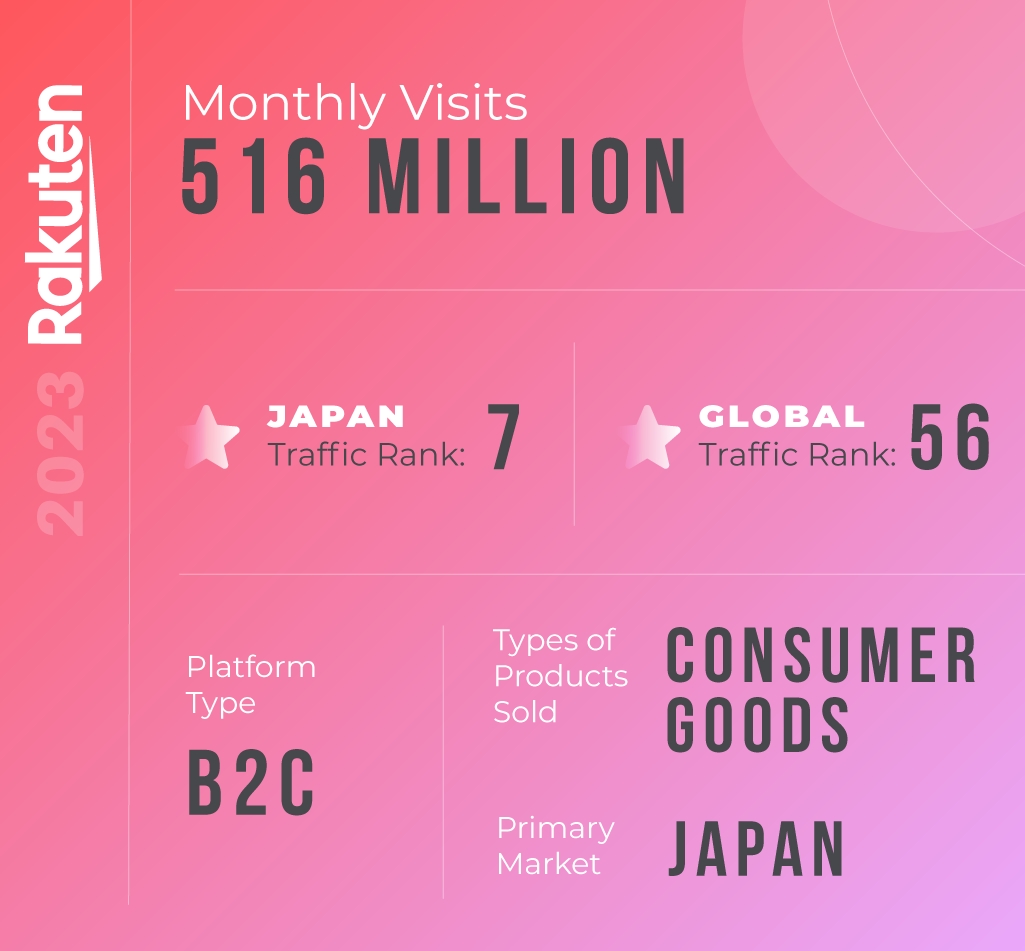
Many have described Rakuten’s e-commerce model as a virtual shopping mall experience where visitors can “walk through” the doors of their favorite brands and browse what’s on offer.
This differs from Amazon’s approach where brands and seller accounts are not prioritized in the user journey, instead focusing primarily on how products compare directly to other products.
This ability to go beyond the initial search results page continues to attract Japanese shoppers who want to browse and discover a wider range of products from a single brand. However, to the foreign eye, this kind of virtual ecosystem may appear somewhat unnecessary or even overwhelming.
Key Platform Features
- As well as an initial product search results page, brands are required to build their own digital storefronts where they showcase branded visuals, special deals, band information, and more products
- Rakuten’s Points program is extremely popular in Japan, with members receiving benefits like cashback and discounts
International merchants can opt for in-country warehousing models such as the Rakuten Super Logistics solution - Much like Amazon’s FBA, it offers cross-border freight management, multichannel order fulfillment, and return management for online orders
Tips for Selling On Rakuten
One of the biggest challenges when selling on Rakuten in Japan is developing your virtual storefront. While it offers the potential for you to truly impress potential customers with the power of your branding, it takes considerable commitment to customize themes, layouts, and marketing content so they’re optimized for conversions.
In our experience, brands with lower brand recognition in Japan (or none at all) will find it harder to win over Japanese customers on Rakuten than Amazon, due partly to the inherent preference for domestic brands. Unpolished or amateur-looking stores will face lower monthly sales and risk potential damage to brand credibility
Setting up a seller account can also be difficult for sellers with minimal knowledge of the platform or no native Japanese language abilities. We typically recommend that businesses seek a local partner to support them during the set-up process.
Yahoo! Shopping
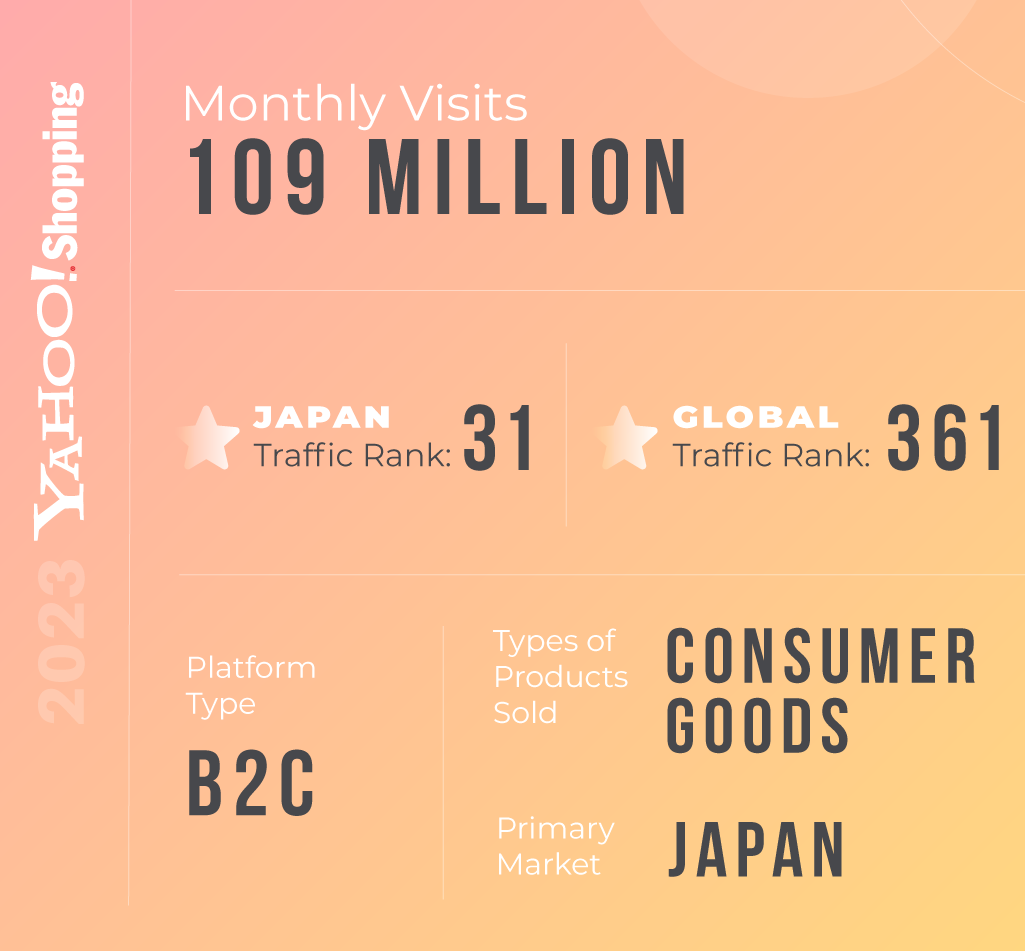
In addition to several digital services and products owned by parent company Z Holdings Corporation, including Yahoo! News (one of Japan’s most popular news channels), Yahoo! Shopping is still one of the most-used e-commerce platforms in Japan.
As well as long-term loyalty from an aging user base, one of the biggest advantages this platform has is its ability to redirect searches through Yahoo! search engine to shopping product listings. Given Yahoo! still retains almost 15% of the nation’s search market, this is substantial.
Recently, Yahoo! Shopping also merged with PayPay Mall to offer a consolidated effort to compete with the likes of Amazon and Rakuten. This move brought together the more premium offerings of PayPay Malls participating brands with the extensive user base of Yahoo! Shopping.
While this may not be enough to keep up with the growth of other platforms, Yahoo! Shopping still presents ample opportunities for sellers to target older users who continue to use Yahoo! services as their preferred option over newer entrants.
Key Platform Features
- As well as traditional product search results listing, Yahoo! Shopping now lets brands set up a virtual storefront and control the overall aesthetic of this space with a number of basic templates available for building a store
- The platform is integrated with PayPay Bonus, PayPay Bonus Lite, and T points which all have large user bases in Japan
- Yahoo! Has introduced improved analytics capabilities that allow sellers to monitor and analyze traffic to their pages, as well as demographic and user behavior data
Tips for Selling On Yahoo! Shopping
Yahoo! Shopping requires foreign companies to register their company locally, or work with a local agency to set up accounts on their behalf. As part of the registration process, you may need to submit official documents proving your company’s legal status in Japan and potentially even copies of relevant tax documents.
There is also greater responsibility for businesses to handle customer service issues themselves, typically requiring the establishment of a domestic support team who speak Japanese.
As such, we would recommend merchants considering Yahoo! Shopping to work closely with a local partner to support activities on this platform or at the very least advise you during the set-up process.
Yahoo! Auctions
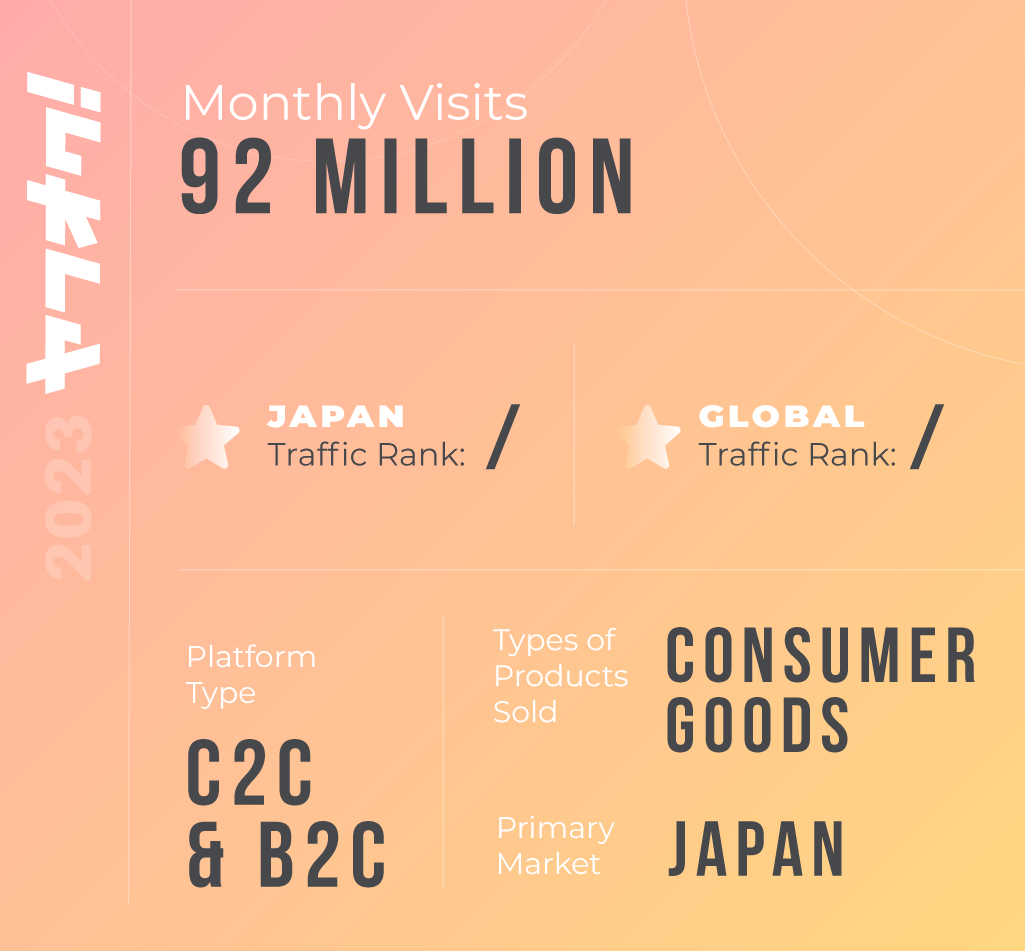
Yahoo! Auctions was initially set-up to compete with eBay in the Japanese market. It has since evolved to offer a range of features and services that many newly established C2C platforms like Mercari have become famous for.
In short, this is Yahoo! Shopping’s ‘flea market’ counterpart where users can buy and sell all kinds of products, from used clothing to big-ticket items like furniture or electronics.
The platform has flourishing communities of collectors in several fields, including anime/manga, gaming, Japanese toys and Japanese American fashion wear, among other things.
Key Platform Features
- Yahoo Auctions offers both auction based listings as well as ‘direct purchase’ listings, where users can purchase a product immediately for a price fixed by the seller
- Ratings, reviews and sales history all contribute to a sellers profile credibility and the way products are treated by the platform’s search algorithm
- Sellers can launch products at any starting price, from as low as 1 JPY
Tips for Selling on Yahoo! Auctions
Whether you’re an individual seller or small businesses selling niche items, seller credibility is incredibly important on Yahoo! Auctions.
As well as giving preferential treatment in search results to accounts that are fully verified and have ample reviews, ratings and product listings, the platform actively blocks sellers that have bad ratings by default.
Building up your platform credibility as soon as possible is important if you want to use it on an ongoing basis. This might involve selling items for cheaper initially to create a positive sales record and focusing more intensively on your customer service approach when you’re getting started.
Mercari
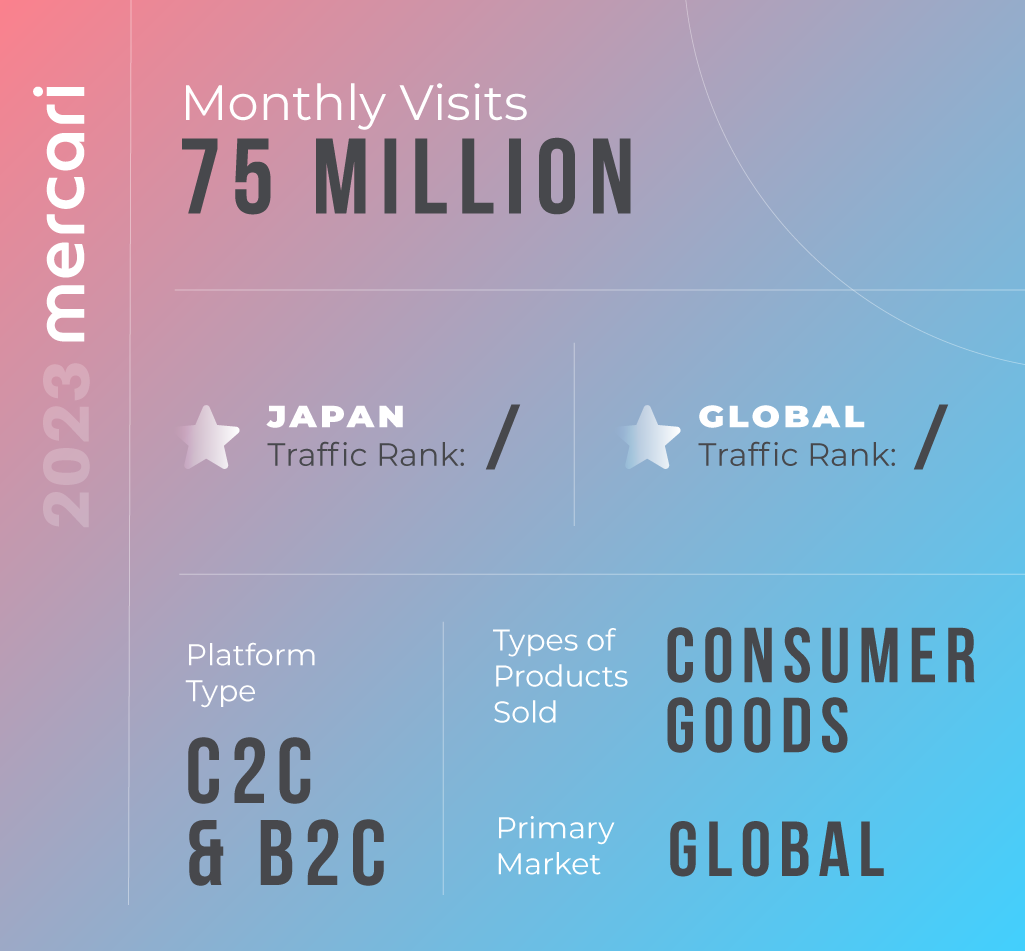
Mercari is Japan’s most popular flea market app and one of the nation’s first unicorn companies following rapid growth after its initial launch.
Today, it has a recorded 20 million monthly active users and an ever growing cohort of members who use it to buy and sell all kinds of products everyday. We don’t think it’s an overstatement to say the impact of this app and others like it have had a profound impact on the way people shop in Japan.
Many are now encouraged to purchase new high-quality products with the knowledge they can eventually sell it for a decent resale price on Mercari, while others use it as a way to purchase rare or unique items that are either no longer available in shops or bespoke.
Importantly, the platform leverages advanced app technology and AI to improve the mobile user experience and drive ongoing usage. This includes facial recognition, dynamic pricing and payment processes that are flexible and efficient.
Key Platform Features
- In-person meetups are restricted and sellers are required to ship the merchandise to buyers while Mercari processes all payments centrally to reduce fraud or transaction friction
- The platform has invested in user identification verification processes and review systems to help ensure users feel safer and more confident with their purchases
- Seller accounts are free to set up but Mercari charges a flat sales fee of 10%
- Product categories are broken down into segments, but the app also has a sophisticated search and tagging system that browsers can use to find products
Tips for Selling On Mercari
Although the platform was created with individual sellers in mind, it has also launched features that make it easier for sole traders and businesses to open digital storefronts. However, this was primarily designed to support creators, producers and small businesses who have been a vital component of the apps ecosystem from the start.
For instance, Mercari is a popular space for sellers of vintage or collectible items, as well as iconic fashion wear from America and army surplus. If you are a seller in these categories, the app could be a perfect place to target a more niche demographic of buyers.
When considering Mercari as a sales channel, do your research into your product segment and see if other brands are offering something similar.
Even though you may be able to set up a branded storefront, you may not have the same kind of interest if your products don’t offer the kind of affordability or unique appeal that people expect when browsing peer-to-peer flea market marketplaces like this.
ZOZOTOWN
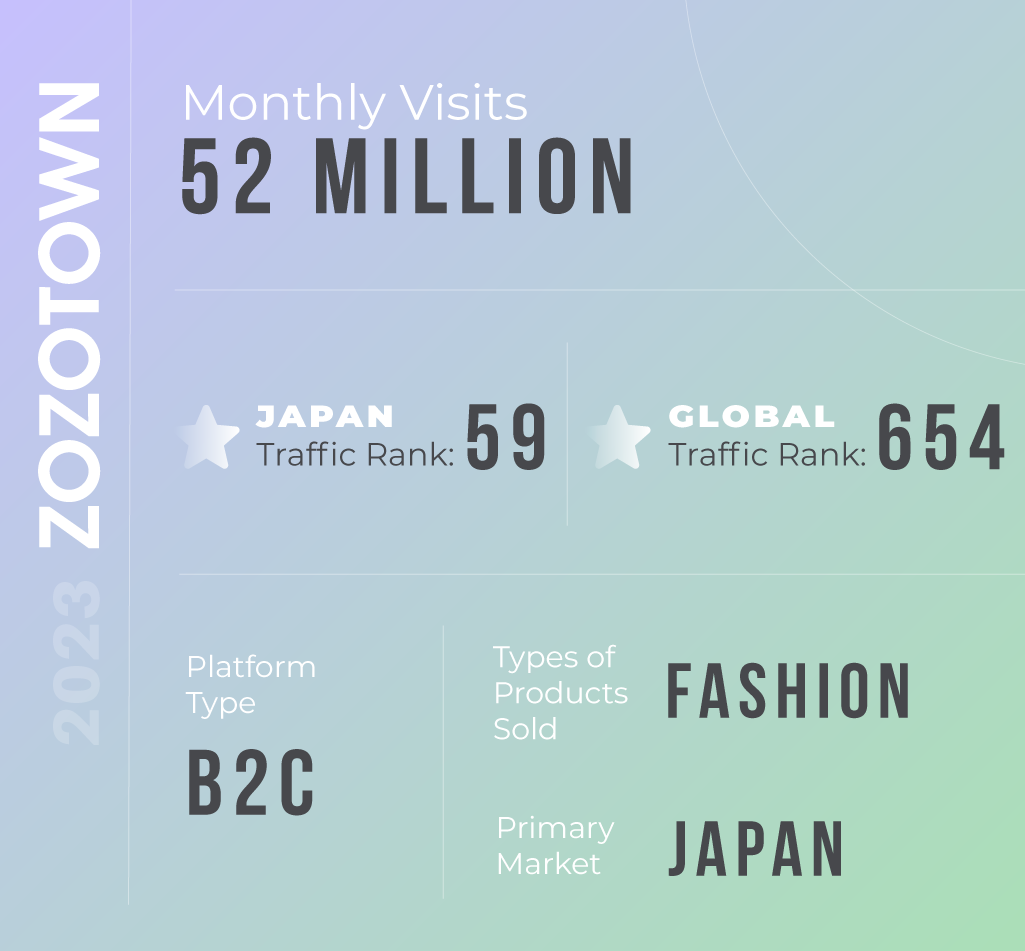
ZOZOTOWN, featuring both Japanese and international brands, is probably the best e-commerce platform in the country if you’re looking to buy trending fashion brands or want to sell to people who are.
Many Japanese shoppers know it as an access point for newly released and limited edition products that can’t be found on other online marketplaces.
Where other platforms cater to a much wider section of society of all demographic variation, ZOZOTOWN has a much narrower target audience and uses knowledge of their interests and preferences to optimize its marketing, products, web content, overall design and UX.
Key Platform Features
- ZOZOTOWN offers users a more premium user experience and draws in many trend-conscious shoppers with an appetite for Western brands that are currently trending (both domestically and internationally)
- The platform also publishes a physical and digital fashion magazine called “WEAR” and operates an app under the same name, giving brands more exposure and helping to inform the decisions of its audience.
Tips for Selling On Zozotown
This isn’t the place people generally go when looking for a bargain, and its appeal is admittedly narrower than other platforms that cater to the mass market.
Nevertheless, This is a great option for western designers seeking to establish their products in Japan and reach younger customers. For brands not in the fashion world or trying to compete on price, not brand uniqueness or quality, this isn’t the best Japanese ecommerce platform for you.
Au Pay (Wowma)
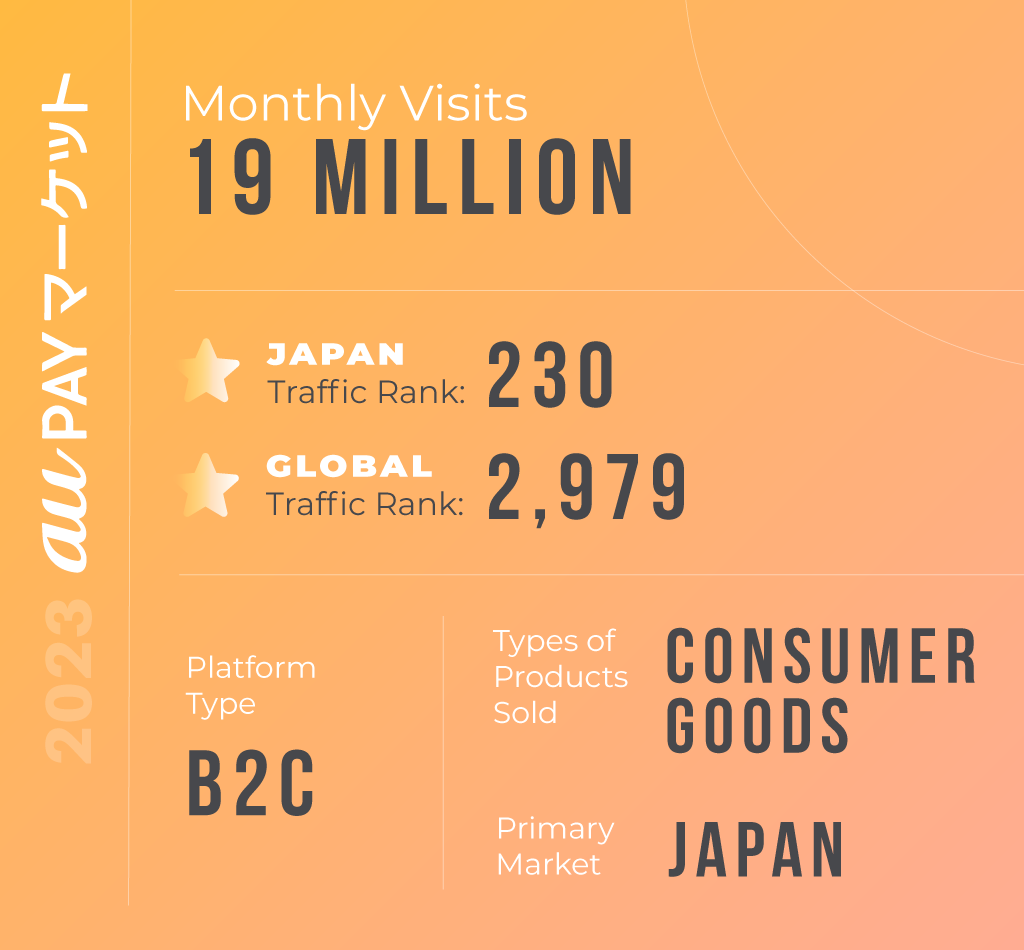
Au Pay, formerly Wowma, is a growingly popular ecommerce marketplace in Japan. Founded by the mobile phone company KDDI who run Japan’s most successful mobile network ‘Au’, the e-commerce platform benefits indirectly from its mother company’s large share of mobile users.
The au brand has over 38 million registered customers, over 14 million subscribers to its ‘smart pass’ app, and over 2500 physical stores in the country—offering ample cross promotion opportunities for sellers using the Au Pay marketplace.
Key Platform Features
Au Pay market regularly guides customers to the platform from other Au Pay services and products (apps, channels, websites etc.)
The platform has both an online and offline market— contributing to a wide network of loyal Au Pay shoppers who enjoy purchasing from affiliated shops and benefiting from the brand’s reward scheme
A rotation of sales periods for different product categories/brands contribute to the platform’s overall promotional calendar and help to shine a light on the products of its merchants
Tips for Selling On Au Pay
Au Pay market has a high volume of Japanese sellers and products. This includes a range of items that are perfectly suited to Japanese homes and lifestyles, such as compact and foldable home appliances.
Being aware of current local trends in your category is important if you want to stay competitive, as well as understanding how your product’s characteristics, dimensions or branding might deter potential customers.
For instance, larger home appliances like vacuum cleaners or microwaves may not perform as well compared to Japanese products that are less bulky.
Qoo10
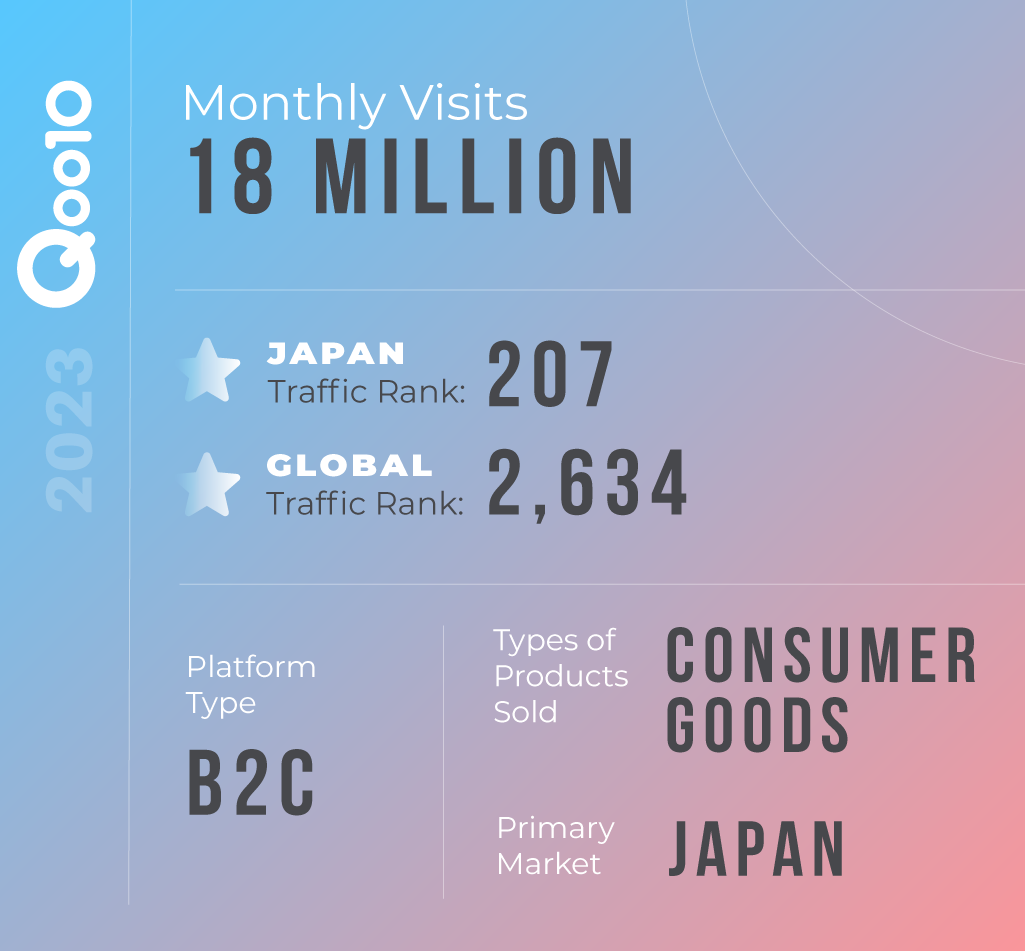
Owned now by eBay, Qoo10 is a fast-growing online marketplace headquartered in Singapore but with a strong Japanese user base.
It draws from a vast knowledge of e-commerce experience from its parent company as it sells products from a wide range of categories, such as fashion, beauty, sports, digital, mobile, home living, living, food, baby, entertainment, and books, welcoming all kinds of sellers.
The platform aims to create an online environment that is “fun” as well as convenient—adapting in-platform product category pages and aesthetics to highlight lifestyle interests such as ‘outdoors & camping’, ‘healthy living’ and’ daily necessities’.
It is also active when it comes to tracking consumer trends and displaying popularity rankings for brands and products on the website’s homepage.
Key Platform Features
- Qoo10 puts particular focus on offering user reviews to support customer purchasing decisions. It incentivises users on the behalf of merchants to leave reviews
- Provides a “photo review” function in addition to regular reviews so customers can review the products in more detail than on some other platforms
- Regularly delivers notifications of discounts and coupons to customers through email to entice users to shop and save
Tips for Selling On Qoo10
Investing in ways to get customer reviews is important on Qoo10. While the platform does its best to encourage feedback and reviews on behalf of sellers, conversion rates can be significantly boosted by merchants making sure to do everything possible to guarantee a solid customer experience.
This can include things like making sure your product images and descriptions accurately convey the product as well as adding friendly greetings cards or discount codes with product deliveries. This may help you meet the high expectations for peer recommendations and social proof on the platform.
Top First Party Online Selling Platforms in Japan By Net Sales

*Tap or Hover on the graph below to see details.
Source: Statista
Japanese Ecommerce Trends and Insights for 2023

While not all specific to Japan, below are some key trends taking place in the Japanese ecommerce space in 2023.
Japan’s C2C E-commerce Market Grows
In some ways, C2C selling platforms are the perfect addition to Japan’s ecommerce ecosystem. With the inherent lack of space in Japanese households, apps like Mercari allow sellers to make room for new stuff in their homes by letting them easily sell things they no longer want or need.
These typically mobile-friendly platforms offer engaging user interfaces on smartphone applications, a growing network of participating sellers, and the ability to acquire almost-new products at a considerable discount.
While these markets are built primarily for consumers to sell to other consumers, we’ve seen several instances of businesses setting up accounts as well. For instance, sellers of specialist or vintage fashion from Europe or America such as watches or furniture are very popular in Japan.
Most Popular C2C/Flea Market Apps And Services
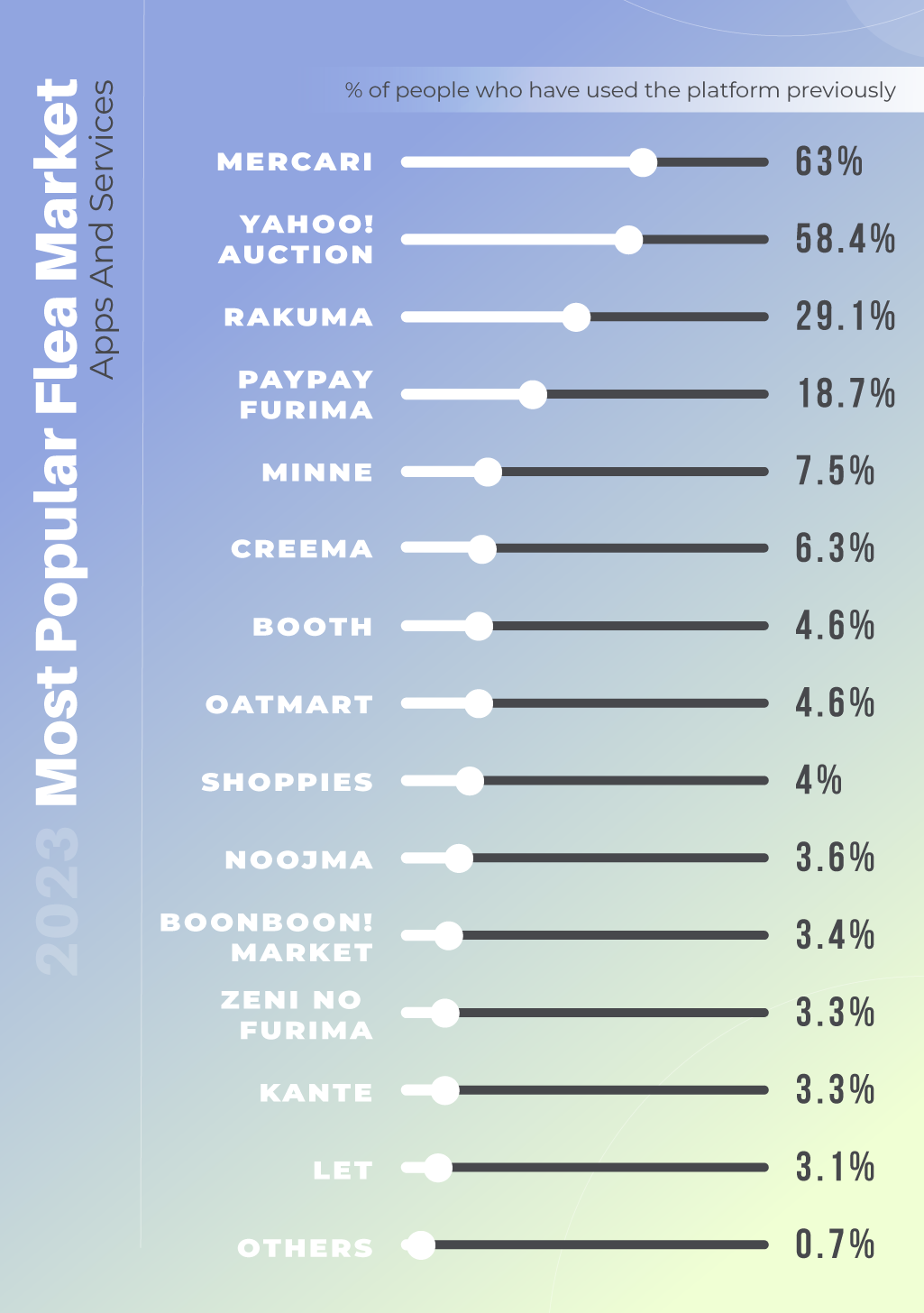
Source: Statista
Peer Reviews and Product Comparison Sites Continue to Influence Consumer Behavior
Japanese consumers are considered more risk-averse than those in many other parts of the world. On Hofstede’s Culture Index, Japan holds one of the highest scores of all societies for ‘uncertainty avoidance’, registering as high as 92/100.
One implication of this is that customers are less willing to take a chance on brands and products they know little about. And many look to peers for reviews and guidance on what they should buy, as well as product comparison platforms.
- 52% of Japanese are partially influenced by online reviews
- 32% of Japanese check review sites before making an online purchase
One such platform used by a huge proportion of Japanese consumers in their online shopping journeys is Kakaku.com—an extremely popular shopping support site where users can compare and examine all kinds of products and services.
This includes everything from detailed tech comparisons and verified user reviews for pretty much any kind of product available online. The platform collates a wide breadth of product information, pricing and user data to offer its browsers transparent advice and product rankings.
Whether it’s through actively encouraging past customers to leave positive feedback or refining your product and customer service offerings, securing good reviews and peer validation has become a major determining factor in whether customers in Japan will be willing to commit to a purchase (especially if it’s from a foreign seller or brand).
Consumer Preferences and Expectations Are Always Evolving

Conscious of rising energy prices, threats to global and regional security, and fears about climate change, Japanese consumers have tightened their belts and realigned their budgets with their personal values.
Once celebrated for their willingness to pay much more for quality and convenience, as well as their love for luxury foreign brands, consumers in Japan have shown increasing interest in cheaper products over the years.
Many are now focused on comparing products based on price (not quality) as a key determining factor when shopping online. They are also more willing than ever to buy more affordable own-brand products instead of goods from well-known brands.
Consumer Purchase Preferences
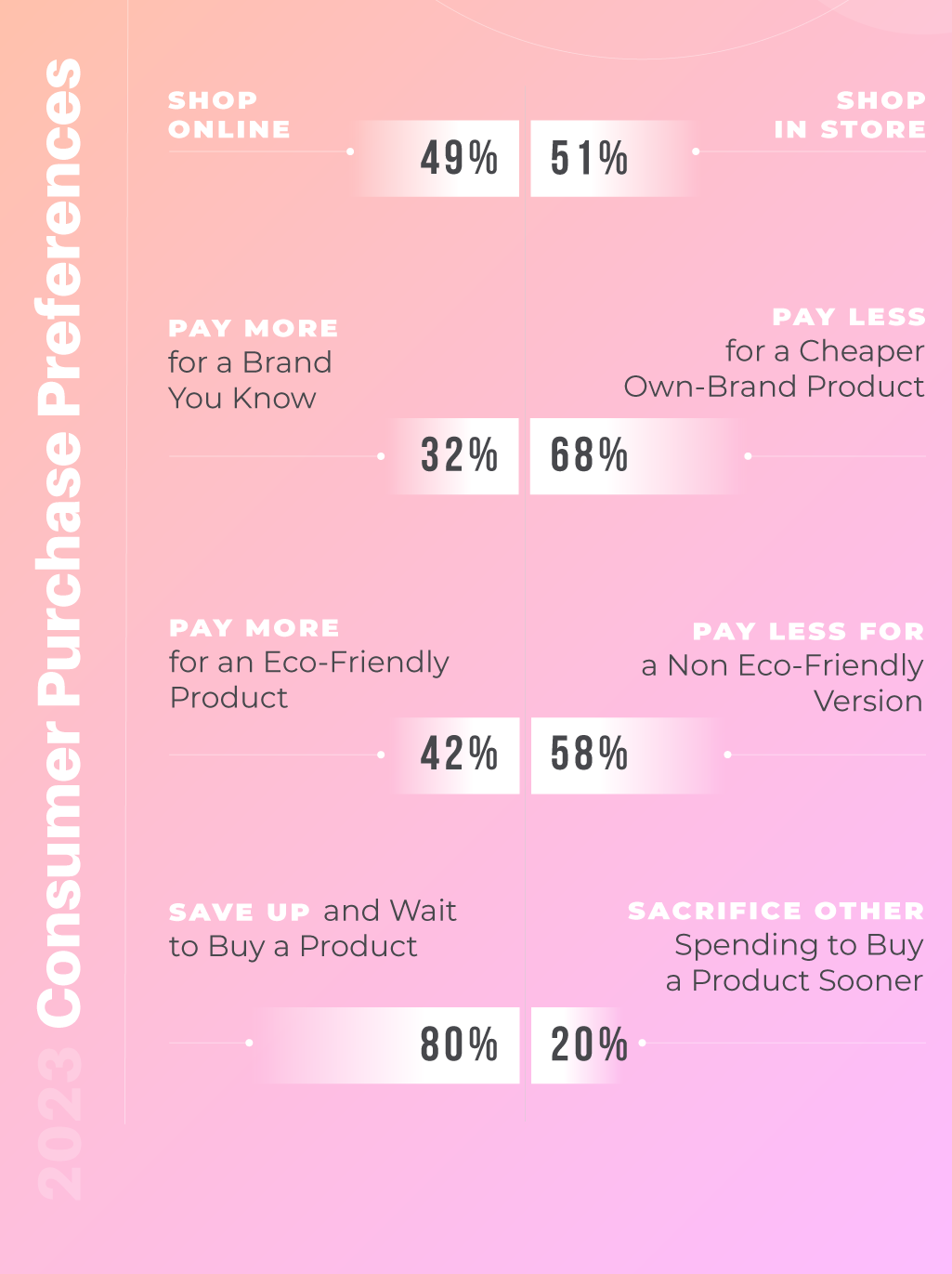
Source: GWI
Key Drivers of Online Purchases
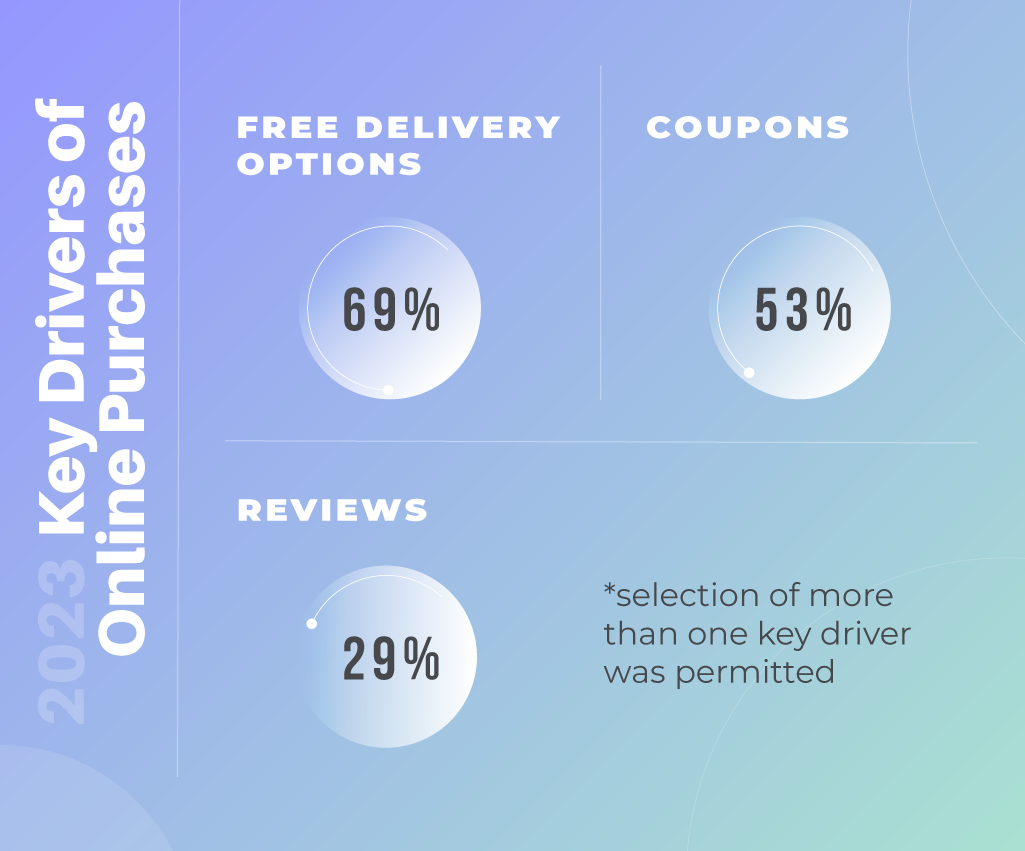
Source: GWI
Loyalty Programs Remain Integral to E-commerce Success

For several years, rewards systems have been a popular way for brands and retailers to encourage customers to become frequent shoppers.
It is also another way that increasingly price-conscious individuals are making their online purchases more budget-friendly.
Point cards and loyalty programs are everywhere in Japan and most online merchants and retailers offer some form of rewards program. Rakuten Super Points, for example, allows sellers to tap into a vast network of members who are already invested in collecting points with the e-commerce giant.
We’re also seeing a number of strategic partnerships being formed through joint loyalty programs, especially in sectors such as hospitality where businesses can benefit from a wider group of customer members.
Top 10 Most Used Loyalty Reward Point Schemes In Japan
*Tap or Hover on the graph below to see details.
Source: Statista
Japan Loyalty Program Market Size Growth Projections
*Tap or Hover on the graph below to see details.
Source: Statista
Consumers Expect Payment Flexibility
Credit cards are by far the most popular payment method for online shopping in Japan. This is probably due to the fact that many standard debit cards from Japanese banks aren’t compatible with online payments as well as the fact that people see credit cards as a safer way to pay.
That said, online shoppers pay in multiple ways today and by offering multiple payment options, retailers and marketplaces can capture a greater number of online sales.
Visa, Mastercard, and JCB are the most widely used and accepted cards in online shopping in Japan but below are some other popular payment methods.
- PayPay
- LINE Pay
- Rakuten Pay
- Origami Pay
- D-barai
- merPay
- Pixiv PAY
- pring
- Apple Pay
- Google Pay
Marketplaces are now competing on their ability to offer flexible, secure and rewarding payment journeys as a way to differentiate themselves from each other.
Preferred Payment Methods for Online Purchases in Japan
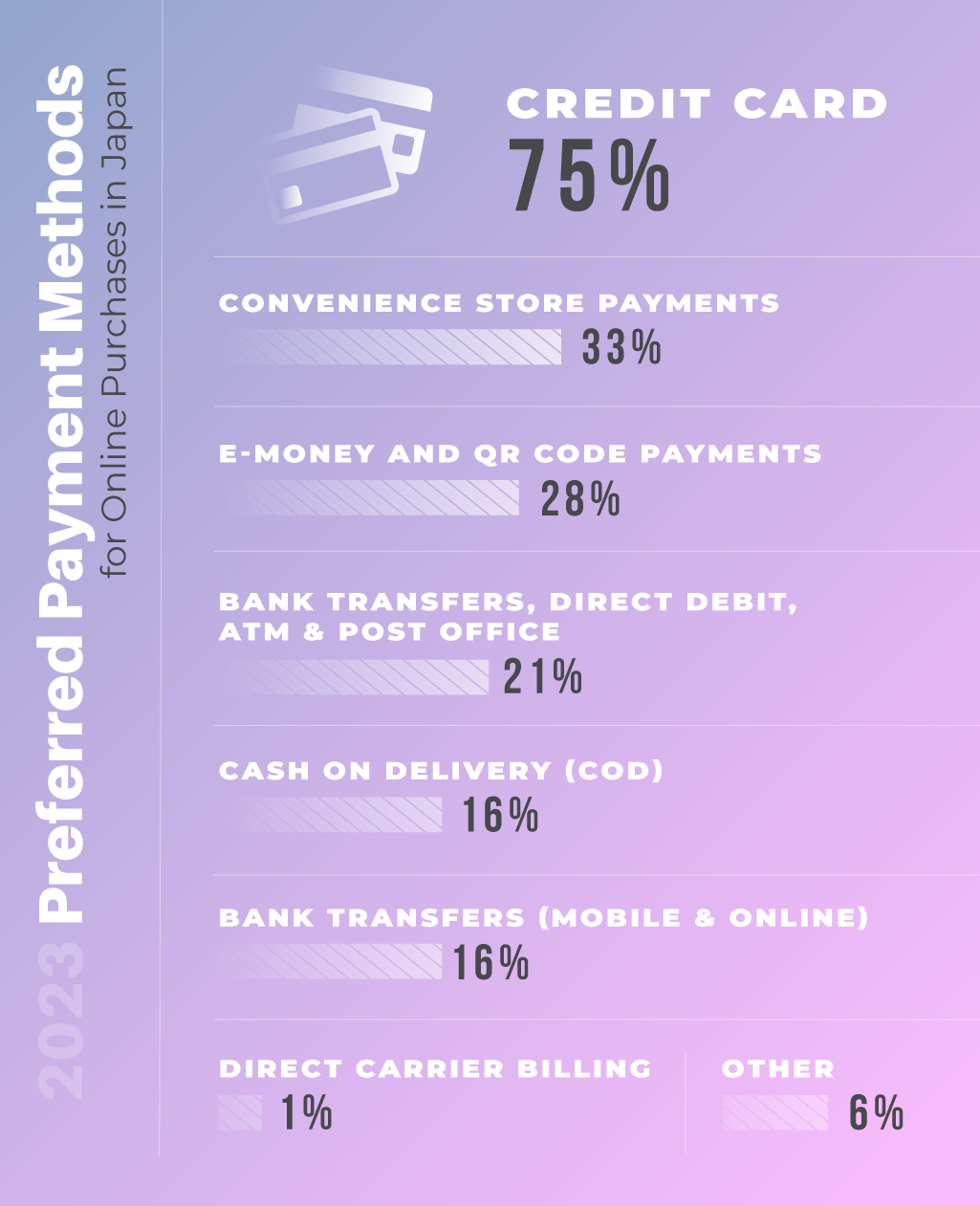
Source: J.P.Morgan, Statista
Forecasted Growth of Buy Now Pay Later Market (BNPL)
Mirroring a global trend, consumers in Japan have become strong adopters of Buy Now, Pay Later (BNPL) payment options and growth is predicted for this fast-growing segment of the payments market.
*Tap or Hover on the graph below to see details.
Source: Statista
Japan’s B2B E-commerce Market Is Set to Grow
Japan is home to a massive B2B ecommerce industry that exceeds 370 trillion yen. Wholesale sales account for the largest share of this market at around 101 trillion Japanese yen.
Long-term growth is predicted with driving factors including the nation’s substantial transport manufacturing and electrical equipment manufacturing industry and its strategic location at the center of a large and evolving East Asian B2B ecommerce landscape.
Japanese B2B E-commerce Size By Industry
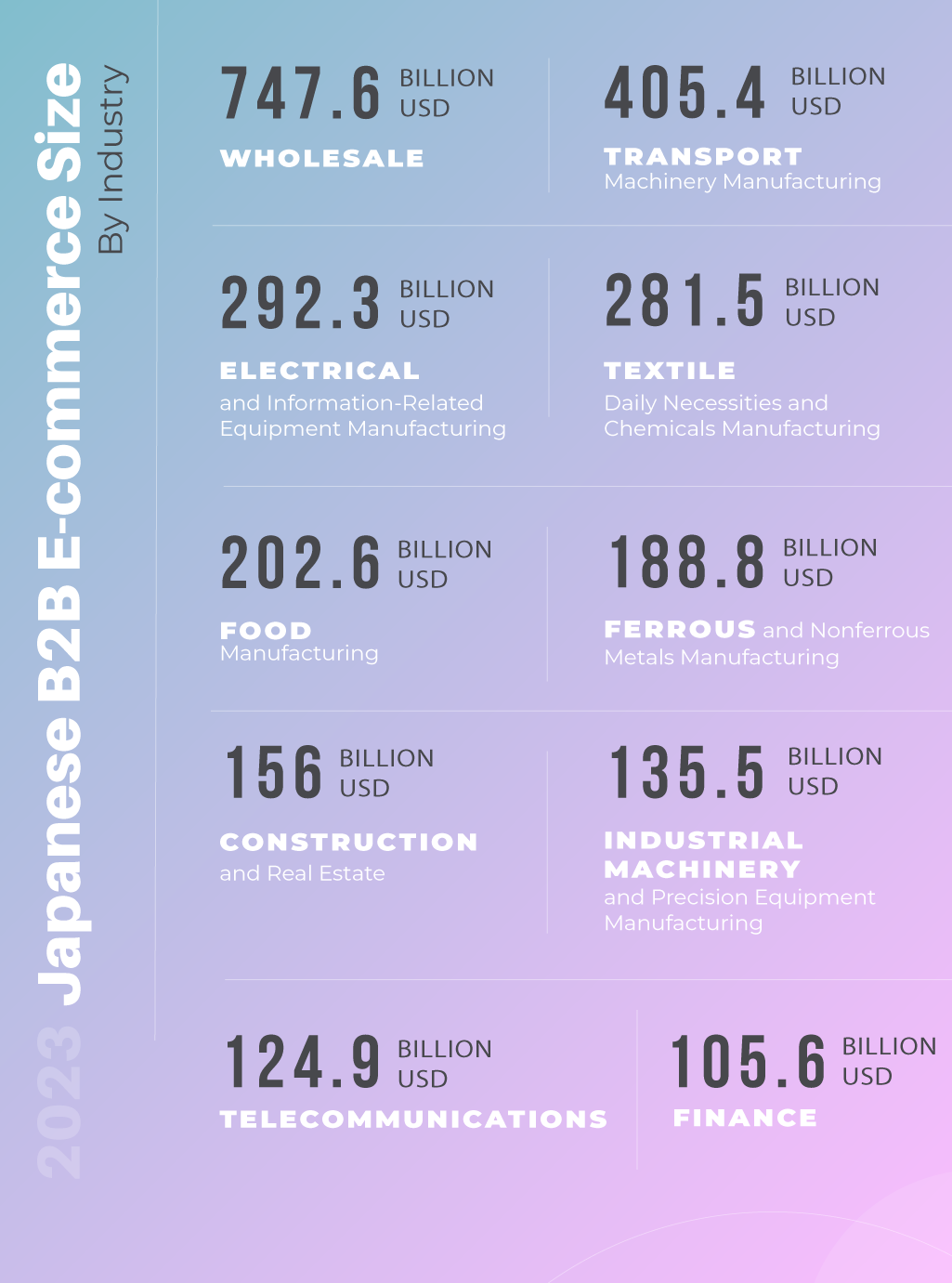
Source: Statista
Expert Insights: Navigating E-Commerce in Japan
We asked Humble Bunny’s Digital Marketing Manager and resident e-commerce expert Julien Lebert about his observations about e-commerce in Japan and his forecasts for the future and here’s what he says:
“In Japan, customer reviews significantly impact sales on platforms like Amazon and Rakuten. Products with just one single 5/5 rating see a clear boost in traffic conversion and sales compared to those with no reviews. Reviews build trust and encourage clicks, making them crucial for success. To stand out, consider offering coupons in exchange for reviews on Rakuten and joining Amazon’s Vine program to get your products reviewed on Amazon.
Looking ahead, both Amazon and Rakuten will likely continue to dominate the Japanese e-commerce market with each platform serving distinct types of consumers. Amazon, with its streamlined interface, caters to those who prioritize a fast and effortless shopping experience. Rakuten, on the other hand, known for its detailed and comprehensive interface, appeals to shoppers who value thoroughness and prefer to check every detail before committing to a purchase.”
Connect with Julien on LinkedIn.
Japanese Ecommerce FAQs
Do I need Japanese language support on my team to sell on ecommerce platforms in Japan?
Offering good customer service support in Japan requires you to have native Japanese speakers on your team or to work with a local partner who offers Japanese language capabilities. Rakuten actually states in its terms that merchants must be highly proficient in Japanese in order to handle everything from customer support, page maintenance, order and return management, marketing campaigns, and operating the shop’s interface.
What’s the delivery/logistics landscape like in Japan?
The delivery market is led by Amazon (Amazon’s FBA service) and Rakuten (Rakuten super logistics). Both are viable options for any foreign brand selling in Japan, however, there are also several domestic shipping and delivery companies like Japan Post, Yamato Transport and Sagawa, whose services have evolved to support ecommerce businesses. If you have your own storage facility or you are partnering with someone who does, there are countless courier services that will help you deliver your products to your customers.
What’s the most recommended cross-border shopping model?
We always recommend using in-country warehousing in Japan, whether you use independent solutions for long-term storage and fulfill the “last mile” (to the customer), or choose to use Amazon FBA or Rakuten Super Logistics to both store and ship your products. This will reduce shipping costs and ensure faster and more reliable deliveries as well as reduce additional friction that might come with shipping products directly from other countries to the end user in Japan.
Which ecommerce platform should I use as a newbie in Japan?
Amazon is typically where most international sellers begin their journey in Japan and the platform we recommend. With a familiar “look and feel” your team can jump straight in and start setting up your products in very much the same way you would in your home market. You can also consolidate listings if desired with the platforms Build International Listings (BIL) feature. Rakuten is also a fantastic platform to sell on — it just takes a little more time and energy to do right!
Methodology
These sources include a range of publicly available surveys as well as official company and government data sets. And where numbers alone have not been enough to paint a full picture of Japan’s most important social media trends, we’ve added our own understanding of the local context gathered from extensive social media marketing activities on behalf of our clients.
Sources:
-
- Statistics Bureau of Japan
- World Bank
- Statista
- DataReportal
- Webretailer
- Edelman’s Trust Barometer
- eCommerceDB
- GWI – Market Snapshot 2022
- CIA World Factbook
- Similarweb
- eMarketer/Insider Intelligence
Steal Our Best Ideas
Actionable insights straight from our data
Here are a couple quick discoveries we’ve pulled from the data of our latest projects. Why? To help you make the changes you need to gain traction in the Japanese market! As an agency, we are always digging deeper and searching for those little yet significant tweaks that will push our clients to the next level of success. If you need a partner to help you identify and implement changes like these on a monthly basis, let us know!
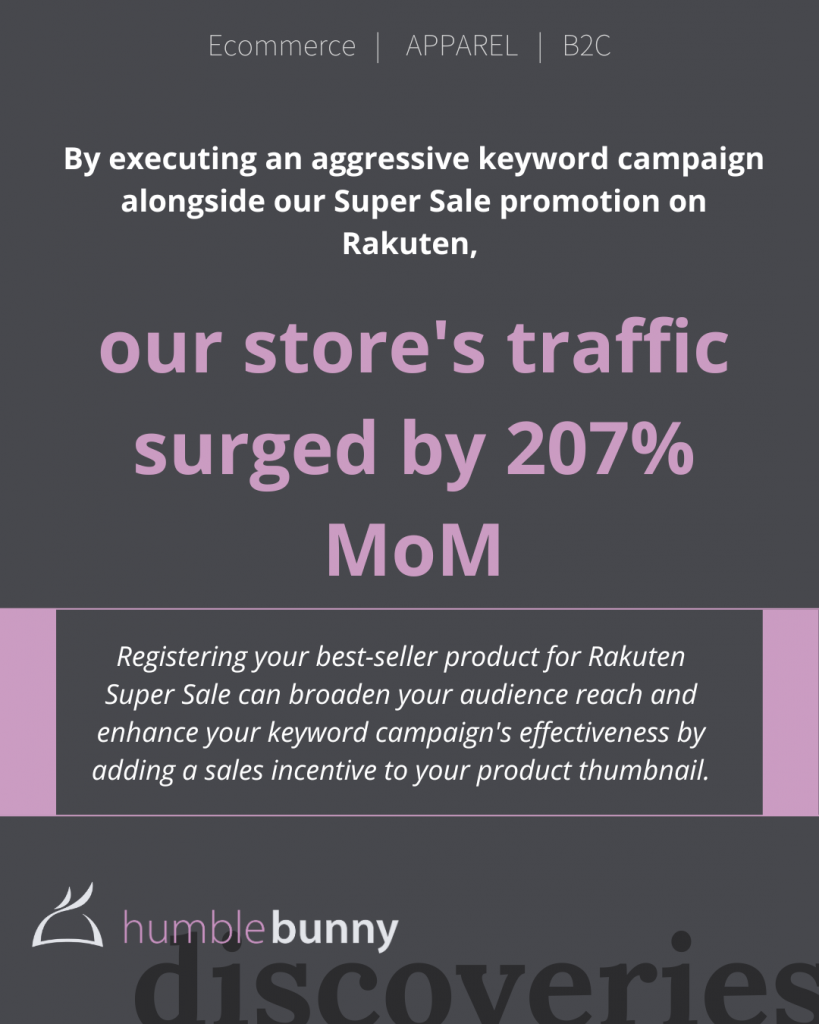


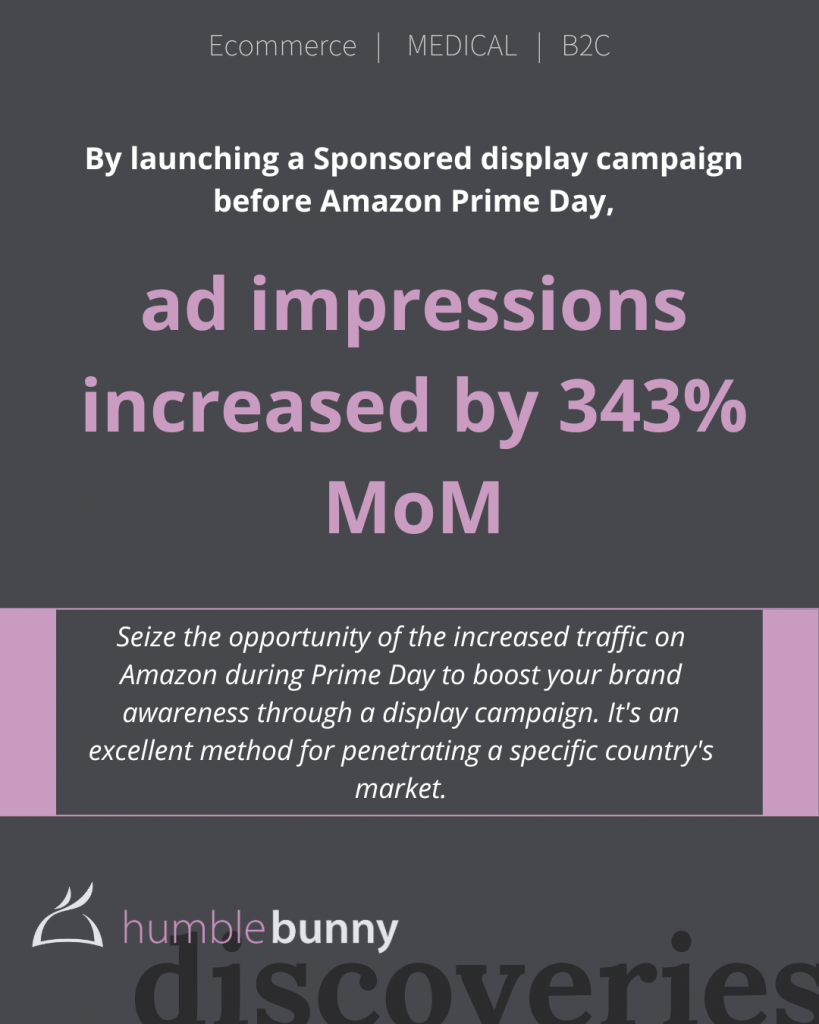
About the Authors & Voices in this Article
Jim KerseyLead Writer |
 |
Paolo RagoneEditor, Contributor |
 |